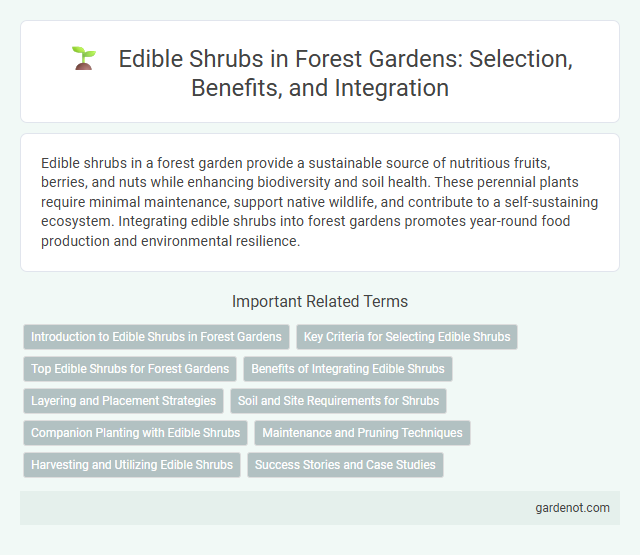Edible shrubs in a forest garden provide a sustainable source of nutritious fruits, berries, and nuts while enhancing biodiversity and soil health. These perennial plants require minimal maintenance, support native wildlife, and contribute to a self-sustaining ecosystem. Integrating edible shrubs into forest gardens promotes year-round food production and environmental resilience.
Introduction to Edible Shrubs in Forest Gardens
Edible shrubs in forest gardens play a vital role in creating diverse, sustainable ecosystems by providing multiple yields such as fruits, nuts, and leaves rich in nutrients. Species like sea buckthorn, currants, and elderberries contribute essential vitamins and minerals while supporting pollinators and improving soil health through nitrogen fixation. Integrating edible shrubs enhances forest garden resilience by offering year-round food sources and habitat complexity.
Key Criteria for Selecting Edible Shrubs
Edible shrubs selected for a forest garden must exhibit high productivity, nutritional value, and adaptability to local climate and soil conditions. Key criteria include drought tolerance, pest resistance, and ease of propagation to ensure sustainability and low maintenance. Nutrient-rich fruits or leaves, combined with perennial growth habits, support both ecological balance and human consumption needs.
Top Edible Shrubs for Forest Gardens
Top edible shrubs for forest gardens include serviceberry (Amelanchier alnifolia), which produces sweet, blueberry-like berries rich in antioxidants, and elderberry (Sambucus nigra), valued for its immune-boosting properties and nutritious dark purple fruits. Currants (Ribes spp.) offer vitamin C-packed berries that thrive in partial shade, while gooseberries (Ribes uva-crispa) provide tart, versatile fruits ideal for jams and desserts. These shrubs contribute to biodiversity, serve multiple ecological functions, and yield harvests that support sustainable food forests.
Benefits of Integrating Edible Shrubs
Integrating edible shrubs into a forest garden enhances biodiversity by providing habitat for pollinators and natural pest predators. These shrubs contribute nutrient-rich berries, leaves, and flowers, supporting year-round food security while improving soil health through nitrogen fixation and organic matter accumulation. Their deep root systems aid in water retention and erosion control, promoting a resilient and sustainable ecosystem.
Layering and Placement Strategies
Edible shrubs such as elderberry and currant play a crucial role in forest garden layering by occupying the mid-layer between herbaceous plants and canopy trees, optimizing sunlight capture and space utilization. Strategic placement of these shrubs near nitrogen-fixing plants enhances soil fertility, promoting healthier growth and increased yield. Incorporating edible shrubs in layered planting designs supports biodiversity, improves microclimate conditions, and maximizes edible biomass production in forest garden systems.
Soil and Site Requirements for Shrubs
Edible shrubs in a forest garden thrive best in well-drained, fertile loamy soils rich in organic matter to support healthy root development and nutrient uptake. Site selection should prioritize partial to full sunlight exposure, with protection from strong winds to prevent moisture loss and physical damage. Maintaining a slightly acidic to neutral pH (5.5 to 7.0) optimizes nutrient availability and supports robust shrub growth.
Companion Planting with Edible Shrubs
Edible shrubs like currants, gooseberries, and elderberries serve as excellent companion plants in forest gardens, enhancing biodiversity and nutrient cycling. Their deep root systems improve soil structure and access nutrients unavailable to shallow-rooted companions such as herbaceous vegetables and annuals. Integrating these edible shrubs promotes pest control by attracting beneficial insects and provides microclimate benefits, boosting overall garden productivity and resilience.
Maintenance and Pruning Techniques
Edible shrubs in forest gardens require regular maintenance to enhance growth and fruit production, with pruning essential to remove dead or diseased branches and shape the plant for better sunlight exposure. Techniques such as thinning out crowded stems and cutting back overly vigorous shoots help improve air circulation and reduce pest infestation risks. Optimal pruning times vary by species but generally occur during late winter or early spring before new growth begins.
Harvesting and Utilizing Edible Shrubs
Harvesting edible shrubs involves picking fruits, leaves, or shoots at their peak ripeness to maximize flavor and nutritional value. Utilizing these shrubs can enhance forest garden biodiversity by providing diverse food sources, supporting wildlife, and contributing to year-round edible yield. Popular edible shrubs such as currants, elderberries, and sea buckthorn offer rich vitamins, antioxidants, and versatile culinary uses in jams, teas, and salads.
Success Stories and Case Studies
Moringa oleifera, an edible shrub, has been successfully integrated into forest gardens in arid regions, enhancing food security and soil fertility. In Kenya, farmers reported a 40% increase in household nutrition after incorporating moringa leaves into their diets, alongside improved income from selling surplus harvests. Case studies from India highlight moringa's drought resilience and rapid growth, making it a vital component of sustainable agroforestry systems.
Edible shrub Infographic

 gardenot.com
gardenot.com